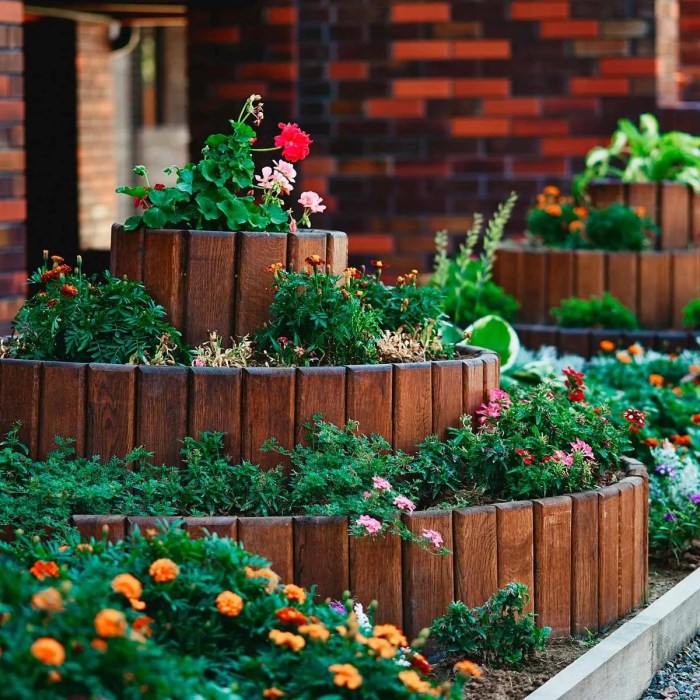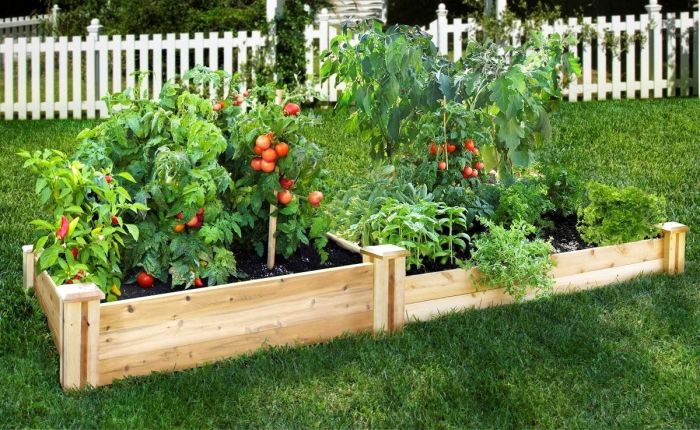Embark on a journey to explore the best plants for raised bed gardens, a haven for gardeners seeking bountiful harvests and vibrant landscapes. Raised bed gardening offers a myriad of benefits, making it an ideal choice for cultivating a wide array of plant varieties.
From delectable vegetables to aromatic herbs and eye-catching flowers, this comprehensive guide will provide you with the knowledge to select the perfect plants for your raised bed garden, ensuring optimal growth, pest resistance, and aesthetic appeal.
Best Plants for Raised Bed Gardens

Raised bed gardening offers numerous benefits, making it an ideal option for growing various plant types. Elevated beds improve drainage, extend the growing season, and allow for better soil control. They are also suitable for small spaces and urban areas.
Factors to Consider
When selecting plants for raised bed gardens, consider the following factors:
- Soil type:Choose plants suited to the soil type in your raised bed.
- Sunlight availability:Select plants that thrive in the amount of sunlight your garden receives.
- Companion planting:Plant compatible species together to enhance growth and deter pests.
Vegetables for Raised Bed Gardens

Raised bed gardens offer an ideal environment for cultivating a wide variety of vegetables, maximizing space efficiency, yield potential, and disease resistance. Here are some of the best vegetable varieties to consider for raised bed gardening:
Tomatoes
Tomatoes thrive in raised beds due to their excellent drainage and aeration. Indeterminate varieties, such as ‘Brandywine’ and ‘Cherokee Purple,’ are ideal for vertical trellising, maximizing space and improving air circulation. Determinate varieties, like ‘Celebrity’ and ‘Early Girl,’ offer compact growth and earlier harvests.
Peppers
Peppers, including bell peppers, chili peppers, and jalapeños, benefit from the warmth and protection provided by raised beds. They require well-drained soil and plenty of sunlight. Popular varieties for raised bed cultivation include ‘California Wonder’ bell peppers, ‘Serrano’ chili peppers, and ‘Habanero’ jalapeños.
Cucumbers
Cucumbers, both slicing and pickling varieties, thrive in the warm, moist conditions of raised beds. Vining varieties, such as ‘Burpless Bush’ and ‘Marketmore,’ require support to climb vertically, saving space and improving air circulation.
Beans
Beans, including bush beans, pole beans, and lima beans, are nitrogen-fixing plants that contribute to soil fertility. They require well-drained soil and adequate moisture. Popular varieties for raised bed gardens include ‘Blue Lake’ bush beans, ‘Kentucky Wonder’ pole beans, and ‘Fordhook 242’ lima beans.
Leafy Greens
Leafy greens, such as lettuce, spinach, kale, and Swiss chard, are easy to grow in raised beds and provide a quick harvest. They prefer well-drained soil and partial shade. Popular varieties for raised bed cultivation include ‘Buttercrunch’ lettuce, ‘Bloomsdale Long Standing’ spinach, ‘Dwarf Blue Curled’ kale, and ‘Bright Lights’ Swiss chard.
Best plants for raised bed gardens come in a variety of shapes and sizes, but one that often stands out is the Ribbon Fern. As described in Ribbon Fern: An Enduring Beauty Unveiled , this resilient plant boasts graceful, arching fronds that add a touch of elegance to any raised bed garden.
Whether you’re a seasoned gardener or just starting out, the Ribbon Fern is an excellent choice for raised bed gardens, offering year-round beauty and minimal maintenance.
Herbs for Raised Bed Gardens

Herbs are an essential part of any raised bed garden, providing culinary, medicinal, and pest-deterrent benefits. Some of the most popular herbs that thrive in raised beds include basil, parsley, thyme, rosemary, and oregano.These herbs are easy to grow and can be used fresh or dried.
They are a great way to add flavor to your favorite dishes, and they can also be used to make teas, tinctures, and other natural remedies. In addition, many herbs are known to attract beneficial insects and repel pests, making them a valuable addition to any garden.
Basil
Basil is a warm-season herb that is native to Asia. It is a popular ingredient in Italian and Mediterranean cuisine, and it can be used fresh or dried. Basil is a good source of vitamins A, C, and K, and it also contains antioxidants.
Raised bed gardens are an excellent way to grow vegetables, fruits, and herbs. But what are the best plants to grow in raised beds? You can find a wide variety of plants that are well-suited for raised bed gardening, including tomatoes, peppers, cucumbers, beans, and strawberries.
For more information on choosing the right plants for your raised bed garden, be sure to check out Discover the Allure of Indoor Plant Stores: A Guide to Greenery and Decor . This guide provides tips on how to choose the right plants for your space and how to care for them.
It has been shown to have anti-inflammatory and antibacterial properties.
Raised bed gardens offer an ideal environment for cultivating a wide variety of plants. When selecting the best plants for these elevated beds, consider the specific conditions of your garden, including sunlight, soil quality, and available space. For a touch of vertical greenery, incorporate real hanging plants that can cascade down the sides of your raised beds, adding a lush and inviting atmosphere to your outdoor space.
These hanging plants not only enhance the aesthetics of your garden but also provide additional growing space for trailing varieties of herbs, flowers, and vegetables, maximizing the productivity of your raised bed garden.
Parsley, Best plants for raised bed gardens
Parsley is a cool-season herb that is native to Europe. It is a popular garnish and is also used in a variety of dishes. Parsley is a good source of vitamins A, C, and K, and it also contains antioxidants.
It has been shown to have diuretic and anti-inflammatory properties.
Thyme
Thyme is a perennial herb that is native to Europe and Asia. It is a popular ingredient in Mediterranean cuisine, and it can be used fresh or dried. Thyme is a good source of vitamins A, C, and K, and it also contains antioxidants.
It has been shown to have antibacterial and antifungal properties.
Rosemary
Rosemary is a perennial herb that is native to the Mediterranean region. It is a popular ingredient in Italian and Mediterranean cuisine, and it can be used fresh or dried. Rosemary is a good source of vitamins A, C, and K, and it also contains antioxidants.
It has been shown to have anti-inflammatory and antibacterial properties.
Oregano
Oregano is a perennial herb that is native to Europe and Asia. It is a popular ingredient in Italian and Mediterranean cuisine, and it can be used fresh or dried. Oregano is a good source of vitamins A, C, and K, and it also contains antioxidants.
It has been shown to have antibacterial and antifungal properties.
Flowers for Raised Bed Gardens
Raised bed gardens provide an ideal environment for cultivating a wide variety of flowering plants that add beauty and ecological benefits to the garden.
Incorporating flowers into raised bed gardens offers numerous aesthetic and ecological advantages. Flowers bring a splash of color and fragrance to the garden, creating a visually appealing and inviting space. They also attract pollinators, such as bees and butterflies, which play a crucial role in the reproduction of other plants in the garden.
Among the best plants for raised bed gardens are tomatoes, peppers, cucumbers, and zucchini. These plants thrive in well-drained soil and ample sunlight. However, they are susceptible to various pests and diseases, which can lead to spots on the leaves or stems.
For a comprehensive guide to identifying, preventing, and treating these spots, refer to Spots on Plant: A Comprehensive Guide to Identification Prevention and Treatment . By following the tips and advice in this guide, gardeners can ensure the health and productivity of their raised bed gardens.
Variety of Flowering Plants for Raised Beds
A diverse range of flowering plants can thrive in raised bed gardens, including:
- Sunflowers: Tall, stately plants with large, vibrant blooms that attract pollinators and add height to the garden.
- Zinnias: Easy-to-grow annuals that come in a variety of colors and shapes, providing a continuous display of blooms throughout the season.
- Marigolds: Known for their bright yellow or orange flowers, marigolds repel pests and add a touch of cheer to the garden.
- Lavender: A fragrant herb with purple or blue flowers that attracts pollinators and adds a calming scent to the garden.
Companion Planting in Raised Bed Gardens
Companion planting is a gardening technique that involves planting compatible species together to enhance their growth, deter pests, and optimize nutrient utilization. In raised bed gardens, companion planting offers several advantages.
One key benefit is improved growth. When plants with complementary needs are paired, they can support each other’s growth habits. For example, taller plants can provide shade for shorter plants, while groundcovers can suppress weeds and retain moisture.
Companion planting can also enhance pest control. Certain plants release compounds that repel or confuse pests, protecting neighboring plants. For instance, planting basil near tomatoes repels aphids and improves tomato yields.
Additionally, companion planting can improve nutrient utilization. Plants with different root structures can access nutrients from different soil depths, preventing competition and maximizing nutrient absorption.
Examples of Compatible Plant Combinations
There are numerous compatible plant combinations suitable for raised bed gardens.
- Tomatoes with Basil:Basil repels aphids and enhances tomato flavor.
- Carrots with Onions:Onions deter carrot flies, while carrots repel onion root maggots.
- Lettuce with Radishes:Radishes break up compacted soil, improving lettuce growth.
Concluding Remarks

In conclusion, raised bed gardening presents a fantastic opportunity to cultivate a thriving garden, whether you’re a seasoned gardener or just starting your green-thumbed adventure. By carefully selecting the best plants for your raised bed, you can reap the rewards of abundant harvests, aromatic herbs, and vibrant blooms, creating a garden that is both beautiful and bountiful.
User Queries: Best Plants For Raised Bed Gardens
What are the benefits of raised bed gardening?
Raised bed gardening offers several advantages, including improved drainage, better soil aeration, extended growing season, and reduced weed pressure.
What factors should I consider when selecting plants for raised bed gardens?
When choosing plants for raised bed gardens, consider factors such as soil type, sunlight availability, plant size, and companion planting principles.
What are some popular vegetables for raised bed gardens?
Excellent vegetable choices for raised bed gardens include tomatoes, peppers, cucumbers, beans, and leafy greens, known for their space efficiency, high yield potential, and disease resistance.